Part 1 by Peter Hellyer / Part 2 by Colin Richardson
Pictures by Mike Hill
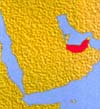 The United Arab Emirates has been acknowledged as one of the top
four destinations in the whole of the Middle East for bird-watching
tours. As regular readers of Arabian Wildlife will know, it is
also the home to significant, though small, populations of the
endangered Arabian leopard and caracal, both foci of attention
for the UAE-based Arabian Leopard Trust, whilst its coastal mangroves
are among the most extensive to be found anywhere around the Arabian
peninsula.
The United Arab Emirates has been acknowledged as one of the top
four destinations in the whole of the Middle East for bird-watching
tours. As regular readers of Arabian Wildlife will know, it is
also the home to significant, though small, populations of the
endangered Arabian leopard and caracal, both foci of attention
for the UAE-based Arabian Leopard Trust, whilst its coastal mangroves
are among the most extensive to be found anywhere around the Arabian
peninsula.Abu Dhabi's natural heritage offers the discerning visitor something more than the readily available sun, sea, sand and shopping. The variety of landscape, habitat, animal and plantlife presents a continuing challenge and absorbing interest to long-term residents of the country and, as thousands of visitors a year are now discovering, even a limited experience of the environment of Abu Dhabi offers a very special reward to the eco-tourist.
Part 1: ABU DHABI
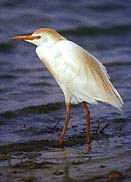 Abu Dhabi Island and Surrounding Areas
Abu Dhabi Island and Surrounding AreasThe capital, home to over 500,000 people is a mixture of high-rise apartment blocks, shopping centres and office buildings, interspersed with some remarkably lush parks and gardens and small but delightful woods, while it is bounded on its eastern side by an extensive mangrove-lined creek, a mere 75 metres or so from a busy Corniche road. The eco-tourist will find that the capital's main attraction is its birdlife, with a variety of interesting resident and migrant species to excite the avid 'twitcher'. Top birding locations include the following:
Bateen Wood and Mushrif Palace Gardens
In the centre of the island, these two sites are a lushly overgrown (and artificially watered) small wood with, just across the road, a fine open park adjacent to the Presidential Guest Palace. Both are attractive to migrants, with species like Masked Shrike, Blyth's Pipit, Eversmann's Redstart and Red-breasted Flycatcher being possible sightings. A number of raptors winter in the area, including Sparrowhawks and Honey Buzzards (rare elsewhere in the Emirates), while Arabia's second Oriental Honey Buzzard was seen over the wood in November 1994.
Eastern Lagoon and Corniche
Several kilometres long, the new Eastern Corniche road runs along the side of the lagoon which is fringed on the other side by some of the best mangroves to be found anywhere along Abu Dhabi's coastline. At low tide, the mudflats attract thousands of waders in winter, many of which, coming from their Siberian breeding ground, like the Greater and Lesser Sandplover or the Terek Sandpiper, are much sought after by visiting birders. Resident species, including the Western Reef Heron and Little Green Heron, while during the winter months, the grassy verges and the mangroves overlooking the lagoon are popular sites for flocks of Cattle Egrets.
In the lagoon itself, the occasional humpbacked dolphin can be seen idly swimming along, 20 or 30 metres from land. Dolphins are more easily encountered, however, by taking a boat trip out from the Intercontinental Hotel on the western side of the island, towards the neighbouring islands of Bahrani and Futaisi (the latter closed to the public), while the sand banks and shorelines can accommodate literally thousands of seabirds during the winter months, including local specialities like the Slender-billed Gull, Lesser-crested Tern and Socotra Cormorant, the latter virtually endemic to the southern Arabian Gulf.
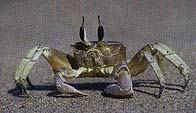 Al Ghar and Al Wathba
Al Ghar and Al Wathba
Good birding can be found at the Al Ghar Lake and the Al Wathba Camel Track around 40 km inland. In 1993, the former held Arabia's first colony of Greater Flamingos for over 70 years, and, provided water is present, is a regular breeding site for Black-winged Stilt and Kentish Plover, while the 10 sq km of grassland in the centre of the Al Wathba Camel Track has produced local rarities like Oriental Skylark, Grey Hypocolius, White Stork, Cream-coloured Courser and Merlin.
The nearby sand dunes, interspersed with rocky outcrops, easily visited without the need for four-wheel-drive skill, hold a variety of other wildlife, ranging from small mammals like the lesser jerboa and gerbils to a range of reptiles, from the sand skink to the larger desert monitor and the vegetarian spiny-tailed agamid. Even if the wildlife doesn't make a showing, the calmness and solitude of the dunes themselves have much to offer the visitor.
The Al Ain Area
The oasis-city of Al Ain has modern parks and gardens like Abu Dhabi, but most visitors find the traditional agriculture of the palm-groves and their falaj water channels more fascinating. Here irrigation techniques that are at least 3000 years old are still in use, even if some of the water today is pumped from a desalination plant on the coast. On a hot summer's day, a walk through the palm groves can be cool and refreshing, with the song of birds like the Little Green Bee Eater, the Palm Dove or the Purple Sunbird as company.
Jabal Hafit, whose summit is now reached by a fine road, is the best place in the UAE to see flocks of Egyptian Vultures, although it is years since the last Arabian tahr was seen on the mountain. The vultures, and other raptors, like the occasional Golden Eagle, find plenty of food in the nearby Al Ain Zoo, the largest zoological gardens in the Middle East. Free-flying Sacred Ibis can be seen here, as well as endangered Dorcas gazelle, ibex and a host of imported animals and birds, including, remarkably, a flock of penguins that have somehow adapted to the desert conditions.
To the north-east of Al Ain and Buraimi lie the Hajar Mountains, great craggy and seemingly barren peaks composed of some of the oldest rocks in Arabia. Within their wadis are hidden streams of freshwater and little mountain oases, like the Omani village of Aboule, a popular weekending place for residents and visitors alike.
In the mountains, the lucky visitor may see the occasional Arabian gazelle, while the wadi pools and streams, often bedecked with ferns and other rare flora, hold Arabian toads and wadi racers, agile snakes of the Colubrid family, as well as brightly-coloured butterflies and dragonflies. Also resident, though much more cautious of man, with good reason, are a few caracal lynxes. The Arabian leopard now seems to be confined to the higher mountains further north. Those in search of new discoveries should take a look at the small fish in the wadi streams. Local scientists are convinced that there are new sub-species at least out there waiting to be identified.
If a living species or sub-species can't be discovered, there is always the chance of finding an extinct one. The Late Cretaceous rocks that form the mountains were laid down on the seafloor many millions of years ago, and now contain fossilized mussels, echinoids, corals and other marine life. One place to look is the horseshoe-shaped Jabal Hywayyah, inside Oman just outside Buraimi. Known as 'Fossil Valley' to local residents, it can be visited by saloon car, and without visa, and is one of the best places to fossick for fossils anywhere in the region. Numerous previously unknown species of echinoids have been described from here by scientists from London's Natural History Museum, while others, yet to be described, are probably to be found decorating mantelpieces all over Abu Dhabi!
On the edges of gravel plains to the west of Al-Ain caracals and gazelles are sometimes sighted, and the ubiquitous Arabian red fox may be seen almost everywhere, particularly in car lights after nightfall. Also present on the edge of the desert, as well as in and around Al Ain itself, are the UAE's three species of hedgehogs, Brandt's, Ethiopian and the long-eared.
The Western Desert and Liwa
The Western Desert stretches from the highway between Al Ain and Abu Dhabi city across to the western and south-western borders with Saudi Arabia. The population centre of the area was traditionally the Liwa Oasis, a chain of palm gardens sheltering on the leeward side of great rolling sand dunes. Liwa has changed much since it was first described by Wilfred Thesiger nearly half a century ago, with roads, new settlements and farms, but it still retains some of its original character. The new greenery has attracted migrant birds to over-winter, while the Namaqua Dove may also be seen by the lucky visitor as it continues its explosive range extension across the Arabian peninsula. With less than a dozen confirmed records for the whole country, however, it remains one of the UAE's rarest birds; and any visitor fortunate enough to sight one should make sure they submit details to the Emirates Bird Records Committee!
The wildlife is similar to that found in the rest of the desert around Al Ain or inland from Abu Dhabi. The key local speciality for the eco-tourist is geological rather than biological in nature, Abu Dhabi's 'Desert Roses', crystalline assemblages of gypsum and other salts formed as a result of the evaporation of the inland sabkha flats that lie between the major ranges of dunes. The best place to find them is between Liwa and the Shah oilfield to the south, on the very edge of the Rub al-Khali or Empty Quarter.
One of the most amazing sights for the visitor is the rolling fields of fodder and massive tree plantation to be seen down the main road to Liwa, part of the extensive programme of afforestation and agricultural extension that has taken place over the last couple of decades. Some of the plantations cover huge areas. Two in Bainuna, to the north of the region, for example, together cover well over a couple of hundred square kilometres.
These areas, free from the pressure of hunting or of the increasingly serious problems caused by over-grazing, are veritable havens for local wildlife. Last year, in the first cautious step towards the reintroduction of some of the country's endangered animals into the wild, a number of Arabian gazelles were released into one of the larger plantations, where they are now thriving.
Some native mammals can still be found, including not only the common Cape hare, Arabian red fox, jirds and jerboas, but also rarer species, like the timid sand cat, although the hyaena is believed to have disappeared within the last 20 or 30 years. Reports of honey badgers remain unconfirmed - eco-tourists wishing to add to the country's list of wildlife, please note!
The Coast and Islands
The coastline of Abu Dhabi is over 400 km long. Low-lying, often of sabkha sand-flats that stand only a few centimetres above high-tide mark, it has changed much over the past few thousands of years, and the evidence of former coastlines can still be seen. The highway from Abu Dhabi to the western industrial zone of Ruwais, for example, passes across the sabkha, and to the south, inland, the old shoreline can be identified, a low range of hills that mark the beginnings of the desert.
From the sabkha itself, sandstone and limestone hills jut out, some little more than eroded stumps with a mushroom-shaped top, and others that would formerly have been large islands. After heavy rainfall, much of the sabkha can still be flooded. The tops of the mesas are often covered with flint tiles, and it is here, archaeologists believe, that some of the earliest evidence of man's presence in the Emirates may be awaiting discovery.
Close to the edge of the sabkha are over a hundred 'real' islands, separated from the land by shallow backwaters and creeks that represent the drainage channels of a moister time, and often fringed by extensive forests of mangroves. For the visiting eco-tourist, this area can be somewhat frustrating because access to the coast-line is often blocked, either by the difficulty of crossing the sabkha or because large areas have been fenced off as private property.
One of the most fascinating discoveries made in this region has been evidence that some six million years ago, in the Late Miocene, a huge river ran across what is now desert from the mountains and drained into the Arabian Gulf. The sandstone mesas and bluffs that are the eroded remains of the flood plains have yielded the most extensive terrestrial fossil fauna from the period known anywhere in the world, including an early ancestor of the horse, Hipparion abudhabiense, and a previously unrecorded genus of gerbils, Abudhabia baynunensis.
The fossil discoveries were made by a team from London's Natural History Museum, working with the support of the Abu Dhabi National Oil Company, ADNOC, and the Abu Dhabi Company for Onshore Oil Operations, a healthy example of the way in which Abu Dhabi's oil industry is helping to back scientific research into the country's historical, pre-historic and palaeontological past.
Part of the coastline can still be reached easily. At small villages such as Harmiyya fishermen ply their ancient trade. Green or hawksbill turtles breed on the remoter beaches, and dugongs are to be found in some numbers feeding on the seagrasses in more sheltered waters.
Most of the undisturbed inshore islands are not accessible to the general public, a fact that may be frustrating for the visitor, but for the wildlife of the islands, the restrictions are distinctly beneficial. On Abu Al Abayad and nearby Umm Amim, for example, are the only two Crab Plover colonies known anywhere on the Arabian side of the Gulf. The species can be seen on the shoreline of the Dhabbiyah peninsula in winter. On other islands, like Al-Salahah, North Yasat and Kharda are Socotra Cormorant colonies, while terns can be found breeding in summer throughout the islands, particularly on Qarnein, over 100 km, offshore, which had nearly 40,000 pairs of breeding birds in the summer of 1994, including Bridled, Swift, Lesser Crested and White-cheeked Terns, as well as Sooty Gulls.
One island that is gradually opening up to the public, however, is Sir Bani Yas, the private nature reserve of President Sheikh Zayed bin Sultan al Nahyan. Although for historians, the main attraction on the island is the remains of the first pre-Islamic Christian site ever found in the Emirates, those of a more ecological bent will find its eclectic collection of animals fascinating. Where else outside Africa can one see herds of several hundred gazelles, (sand, Arabian and Thomson's) kicking up dust as they spring across the landscape? Arabian oryx can be seen, along with their cousins the scimitar-horned oryx, belsa oryx and jemsbok, while other species breeding happily in the large enclosures or running wild include the addax, waterbuck, and even llamas and giraffe.
Sir Bani Yas and the other offshore islands also act as attractive stopping-over points for migrant birds, including both passerines and the raptors that feed upon them, and the western islands of Abu Dhabi have the bulk of eastern Arabia's breeding pairs of Sooty Falcons, as well as 90 per cent of the region's Ospreys.
Nature Reserves
At the time of writing, there are no formally designated nature reserves within the Emirate of Abu Dhabi, although the area of the Eastern Lagoon mangroves, just to the east of Abu Dhabi island, has been declared a protected area by Presidential order. Access to many of the islands, however, is restricted by their owners, many of whom are concerned with the need to conserve wildlife.
Part 2: DUBAI AND THE NORTHERN EMIRATES
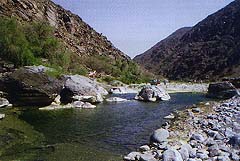 In Dubai and the northern emirates, the serious eco-tourist can
experience an exciting destination, parts of whose culture and
terrain remains in almost pristine condition.
In Dubai and the northern emirates, the serious eco-tourist can
experience an exciting destination, parts of whose culture and
terrain remains in almost pristine condition.
Dubai had already established itself as a quality tourist destination, offering winter sunshine, beaches, cheap shopping and desert safaris, by the time commercially- organized bird-watching tours started in 1992, when a party of German visitors found (to their delight) over 170 species during a 10 day tour. Gone forever was the preconception that there were 'no birds in Arabia'! The potential for growth in bird-watching eco-tourism is underpinned by the fact that the UAE's bird list stands at slightly over 400 species, with Dubai and the northern Emirates arguably having the most species to offer. Of these, 80 are breeding residents and the remainder are migrants from north and central Asia, northern Europe, India and even Africa. On a 10-day tour it is possible to see all the 'difficult' Arabian species, such as Socotra Cormorant, Crab Plover, Sooty Gull, Chestnut-bellied Sandgrouse, Black-crowned Finch Lark, Hume's Wheatear and Purple Sunbird, plus dozens of other Asian migrant specialities.
The Gulf Coast
Wader watchers are in their element in the northern Emirates where a visit to one of the three major wetlands on the Gulf coast should produce an exciting abundance of palearctic shorebirds.
The sheltered tidal lagoon at Khor Dubai, 50 ha of tidal mudflats located within Dubai's city limits, holds over 50,000 birds at any one time during the winter season. Internationally important for its large migrant flocks of Lesser Sand Plovers (up to 3000 counted in winter) and Broad-billed Sandpipers (up to 4000 can occur in autumn), it also supports significant numbers of Kentish Plover (up to 3500 in winter, with a large proportion resident). The most attractive species include Great White Egret, Spoonbill, Greater Flamingo, Marsh Harrier, Spotted Eagle, Osprey and Caspian Tern. The area can be viewed from around the perimeter adjacent to the main roads to Hatta and Al Ain. This site has been declared a Wildlife Sanctuary (the country's only one so far) by Dubai's Crown Prince, Sheikh Mohammed bin Rashid, whose interest in the high numbers of Greater Flamingos occurring throughout the year encouraged him to build a breeding island in the centre of the lagoon. The area is patrolled by the police to prevent disturbance to the birds and you may be asked to leave. This restriction may not be enforced if they see and understand you are simply watching the birds. Passes can be obtained from Nad al Sheba police station.
Further up the coast in Umm al Quwain, an even bigger expanse of mudflats at Khor al Beidah hosts the country's largest wintering flock of Crab Plover (up to 500 birds between September and February), often in the company of the even rarer Great Knot, which until recently was believed to winter only in the Far East and Australasia! These two species are good crowd-pullers for attracting visiting bird-watchers. The extensive khor is also a favoured site of Greater Sand Plover, Whimbrel and Terek Sandpiper. The complex of sheltered intertidal mudflats, islands and mangroves is bounded inland by sabkha (salt flats) and rolling dunes, which host several breeding species of larks, including Black-crowned Finch, Lesser Short-toed and Hoopoe Lark. In winter, Isabelline and Desert Wheatear, Desert Warbler and Tawny Pipit are common. Access to this remote area is by several unofficial dirt tracks.
The spectacular lagoon at Al Jazeerah Khor, south of Ras al Khaimah, where the Arabian Gulf is guarded on the land side by a high bank of red sand dunes from where the observer can get a wonderful view of the mudflats and its bird population.
East Coast beaches and Mangroves
At Khor Kalba on the border with the Sultanate of Oman, is situated the country's (and possibly Arabia's) oldest forest of black mangrove, Avicennia marina. This area, one of the jewels in the itinerary of visiting naturalists, hosts, amongst other creatures, an endemic sub-species of White-collared Kingfisher. At certain times of the year, turtles (green, loggerback and hawksbill ) may enter the khor to feed, while the nearby coastline is favoured by eight species of tern and six species of gull, which roost on the black sandy beach or feed on dead fish lying discarded on the beach. The mangroves are alive with the calls of Clamorous Reed Warblers, Booted Warblers and Purple Sunbirds for most of the year, while Blue-cheeked Bee-eaters roost in spectacular numbers in autumn. The mudflats are teeming with small crabs, the staple diet of several species, including the White-collared Kingfisher and occasionally Crab Plover, Greater Sand Plover and Whimbrel.
The remainder of the eastern coastline teems with gulls, terns and skuas, plus, at the northern end, the occasional Audubon's Shearwater, Wilson's Storm-Petrel or a 'skein' of Socotra Cormorants. Sooty Falcons are regular migrants along here, where the Hajar Mountains form a spectacular backdrop. One is likely to find a variety of birds of prey, including Lappet-faced and Griffon Vulture, Bonelli's, Spotted and Short-toed Eagle adjacent to the dark, apparently featureless hills. There are very few hotels along this coastline, and because of the area's increasing popularity, the two most popular ones, the Fujeirah Hilton and the Oceanic are regularly full. There are also three smaller hotels, and work is going on to build at least two more large hotels, which may be finished by the end of 1996. This is bound to open up the area further for visitors.
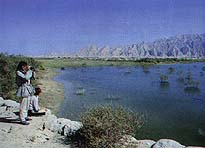 Deserts and Dunes
Deserts and Dunes
A visit to Arabia would not be complete without a trip into the 'desert'. Most visitors are intrigued by the giant sand dunes, reached after less than a 30 minute drive from Dubai. The red sand dunes in the northern Emirates (the most dramatic are found on the Dubai to Hatta road) are small compared to those found further south in the Empty Quarter, but are always worth exploring for signs of life. The most common bird resident is the Hoopoe Lark, while in winter small areas of scrub are likely to attract Desert Wheatear and Desert Warbler. The unique stands of ghaf trees (Prosopis cinerarea characterize the UAE desert and provide a magnet for birds, the most common resident being Great Grey Shrike. During the cool season the trees attract several species of Sylvia warbler (Orphean & Menetries'Warbler and Desert Lesser Whitethroat), while in summer they provide nest sites for Yellow-throated Sparrows.
Qarn Nazwa: Qarn means a 'horn' of rock; in this case a limestone outcrop set in the middle of an expanse of red sand dunes half way between Dubai and Hatta. The outcrop is undeveloped and remains dramatic in appearance in spite of some old quarrying and two roads which dissect the site, providing convenient viewing for the site's well-watched Eagle Owls. The area is important for several rare migrant birds, including Eastern Pied and Red-tailed Wheatear and Hume's Lesser Whitethroat. The caves and cracks in the rock surface support a good vertebrate fauna including red fox and free-tailed bat. The site is fenced from the Dubai-Hatta main road, although easy unrestricted access is available from the road to Margham which branches off here.
The Hajar Mountains
The area around the mountain village of Masafi, which lies at an altitude of 600 metres, has a number of sites worth visiting, particularly on the road to Dibba, where one passes through a range of pale foothills and on to Tayibah plain. The region is quite unspoilt away from the towns and there are lots of wadis to explore. Shale foothills divided by gravel plains with scattered Acacia and Zizyphus trees are set amidst a dramatic mountain landscape comprising one of the most natural, unspoilt and beautiful environments in the UAE. Resident bird species include Bonelli's Eagle, Sand Partridge, Lichtenstein's Sandgrouse, Desert Lark, Hume's Wheatear (easily identified by contrasting black-and-white plumage) and House Bunting. Winter visitors, Red-tailed Wheatear, Desert Lesser Whitethroat and Plain Leaf Warbler are regular.
Most of the mountains are best explored by four-wheel-drive vehicle since walking can be quite difficult. The mountains were formed by tectonic plate movement against the Indian subcontinent, and have volcanic origins deep beneath the seabed of the Gulf of Oman. These dark 'ophiolitic' mountains support resident Sand Partridge, Pale Crag Martin, Scrub Warbler and House Bunting, while Indian Roller, Yellow-vented Bulbul and Little Green Bee-eater are found in the shaded, more cultivated wadis. The key birds for bird-watching visitors occur in winter and include species such as Eastern Pied & Red-tailed Wheatear, Desert Lesser Whitethroat and Plain Leaf Warbler.
Other areas
Mushrif Park lies in a sheltered dip amongst rolling sand desert about 12 km from Dubai Airport. It is a natural ghaf (Prosopis cinerarea) forest although now developed for day visitors, containing an extensive road system and leisure facilities. It supports a healthy population of Bruce's Scops Owl, which are often conveniently found at night under the street lamps. A number of other interesting species occur, including Orphean Warbler and Eastern Black Redstart. Yellow-throated Sparrow and Hoopoe nest in the park. The Ethiopian hedgehog is widespread. The entrance fee is Dhs.10 ($3) per car and the gate timings are 9.00 a.m. to 11.00 p.m..
A bird-watching visit to the Emirates is not complete without
touring the numerous golf courses, city parks and agricultural
areas. Recommended are the Emirates golf course (where special
permission is required), Safa Park and the grass fields around
Digdaga and Hamraniyah, south of Ras al Khaimah. In addition there
are a number of other sites, less known for their beauty, though
teeming with birdlife. These include Ramtha (sewage) lagoons,
a place which holds the country's greatest variety of wetland
species.
Useful Addresses for United Arab Emirates
Emirates Natural History Group, P O Box 2380, Abu Dhabi. Tel 9712-4091555 or 319317. The Group publishes an excellent twice-yearly magazine, Tribulus, and holds bi-monthly meetings open to non-members.
Emirates Natural History Group (Al Ain), P O Box 18057, Al Ain, Abu Dhabi.
Emirates Bird Records Committee, produce the Emirates Bird Report P O Box 50394, Dubai. No 18 includes a month by month diary and a systematic listing of the 309 species seen in the UAE during 1993. The recorder is Colin Richardson.
National Avian Research Centre, P O Box 45553, Abu Dhabi, Tel 9712- 319317; fax 9712 349154.
Emirates Environmental Group, P O Box 70418, Abu Dhabi, Tel 328070. The Group holds monthly
meetings open to non-members.
See also Emirates Birds Records Commitee.
Dubai Natural History Group, P O Box 9234, Dubai. Meets on the first Sunday of every month at the Jumeirah English Speaking School (8.00p.m.). Arabian Leopard Trust, P O Box 12119, Dubai. Tel 9714 444871; fax: 9714 446191.
There are no specialist tour companies based in Abu Dhabi dealing solely with wildlife interest holidays. Hobby Holidays of Dubai, (Colin Richardson), and a number of other European-based companies,
run bird-watching tours that cover the whole of the UAE.
Colin Richardson organizes and leads day (and half-day) birding tours. He offers a choice of three tours, which take in a variety of places and habitats, enabling the business or holiday visitor to see up to 90 bird species in one day. Contact Colin Richardson, P O Box 50394, Dubai, UAE. Tel/fax Dubai 9714- 313378.
Animal Watch/Wolftrail is a joint British/Dutch which organizes an annual spring tour to the Emirates spending 12 days in March touring all the bird sites. Contact Sarah Gillem, Animal Watch, Granville House, Sevenoaks, Kent TN13 1DL. Tel 01732-741612; fax: 01732-740736.
A Swedish group organised by Avifauna visited the Emirates for the first time over the new year period 1994/5 and are planning further 10-day 'no-frills' trips for Scandinavian birders in the future. Contact Erik Hirschfeld, Sodra Forrstadgaten 62, S-211 43 Malmo, Sweden. Tel/Fax (+46) 40 23 74 35.
Autumn tours are now firmly on the itinerary for Birdquest. Contact Mark Beaman, Birdquest Ltd, Two Jays, Kemple End, Birdy Brow, Stonyhurst, Lancashire BB6 9 QY. Tel 0254-826317; fax: 0254-826780.
International Travel and Tourisme Marketing (ITTM) promote an annual 12-day autumn tour to the UAE supported by ornithological organizations in several European countries. Contact Christopher Sheryl, ITTM, P.O. Box 2099, 1211 Geneva 1, Switzerland. Tel/Fax: (41) 22 736 06 34.
Two-day tours to the UAE are promoted in Germany by Natur-Studienreisen, who make sure that all groups are accompanied by a highly experienced German ornithologist/naturalist. Contact Natur-Studienreisen GmbH, Untere Dorfstrasse 12, W-3410 Northeim, Germany. Tel: (49) 5551-99470, Fax: (49) 5551 9947 20.
A 12-day Sunbird tour, supported by the Ornithological Society of the Middle East, plans to visit the Emirates for the first time in October and November 1995. Contact Paul Holt, Sunbird, P O Box 76, Sandy Bedfordshire SG19 1DF. Tel: 01767-682969, Fax: 01767- 692481.
For more general off-the-beaten track scenic tours out of Abu Dhabi, the best choice is Adventure Unlimited of Al Ain. Contact Brian Goggin: P O Box 16031, Al Ain, UAE, Tel/fax: 9713-687458, mobile: 971-50-472854. Offers trips into the wadis of the Hajar Mountains, climbing, camel safaris, potholing in Jabal Hafit and four-wheel-drive desert excursions.
Boat trips from Abu Dhabi island are run by Blue Dolphin, P O 5204, Abu Dhabi. Tel: 9712-669392, Fax: 9712-666802.
For more general tours, including trips to Al Ain, the Liwa Oases and the Western Desert, Sunshine Tours, the tours division of the Abu Dhabi National Hotels Company, P O Box 8200, Abu Dhabi, UAE (Tel: 9712-449914, fax: 4468546) is the largest company, and can also arrange accommodation in five star and four star hotels in Abu Dhabi, Al Ain, and Jabal Dhanna on the coast west of Abu Dhabi.
For tourist information in Dubai contact Dubai Commerce & Tourism Promotions Board, P O Box 594, Dubai, UAE. Tel: Dubai 9714- 511600, Fax: 9714-
511711.
| Subjects | Search
Arabian Wildlife. Volume 2, Number 2